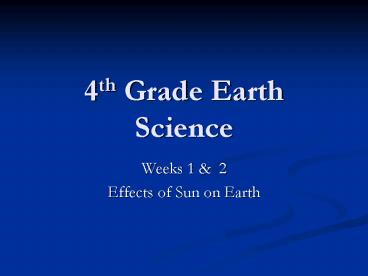4th Grade Earth Science - PowerPoint PPT Presentation
1 / 17
Title:
4th Grade Earth Science
Description:
The outer visible layer of the sun has a temperature of 6,000 C ... Aug. July. June. May. Apr. Mar. Feb. Jan. Houston. http://web2.airmail.net/danb1/climate.htm ... – PowerPoint PPT presentation
Number of Views:1111
Avg rating:3.0/5.0
Title: 4th Grade Earth Science
1
4th Grade Earth Science
- Weeks 1 2
- Effects of Sun on Earth
2
The sun is a star. Our solar system has only one
star.
Sun close-up. Paul Fuqua. (2005). Retrieved
February 14, 2006, from unitedstreaming
http//www.unitedstreaming.com/
3
The outer visible layer of the sun has a
temperature of 6,000C (11,000F). Its light and
heat travels through space to the earth.
http//www.spaceflightnow.com/ news/0003/02sunwarm
ing
4
The Sun is the major driving force behind weather
on our planet.
Sun over water. Paul Fuqua. (2005). Retrieved
February 14, 2006, from unitedstreaming
http//www.unitedstreaming.com/
5
When the sun heats water, the water begins to
evaporate. Approximately 80 of all evaporation
is from the oceans, with the remaining 20 coming
from inland water and vegetation.
http//ww2010.atmos.uiuc.edu/(Gh)/guides/mtr/hyd/e
vap.rxml
6
Because Earth is tilted on its axis, it does not
get direct sunlight everywhere on its surface.
http//www.math.nus.edu.sg/aslaksen/gem-projects/h
m/0102-1-phase/EARTHCLIMATE.htm
7
The suns heat warms the air. Warm air rises, and
cool air sinks.
http//zebu.uoregon.edu/soper/Earth/weather.html
8
Because the earth spins (rotates) on its axis,
the paths of winds bend clockwise north of the
equator. Hurricanes spin clockwise in the
northern hemisphere.
http//zebu.uoregon.edu/soper/Earth/weather.html
9
- Conditions of the earth's atmosphere at a given
place and time are called weather. - Some of these conditions are
- Temperature
- Wind speed
- Precipitation
- Humidity
- Cloud cover
10
Temperature
- The measure of how much heat an object has.
- Heat is how much molecules in an object vibrate.
- The faster the molecules vibrate, the hotter the
object is.
http//schoolnet.gov.mt/physics/HeatEnergy2.htm
11
Temperature
- In America we use the Fahrenheit and Celsius
scales for measuring temperature. - Celsius is the temperature scale that is used in
science.
Fahrenheit
Celsius
Image from Pearson Prentice Hall, Inc.
(2005) http//physics.uoregon.edu/jimbrau/BrauImN
ew/Chap03/FG03mp0101.jpg
12
Wind Speed
The speed of the wind and the direction it is
coming from are important for predicting
weather. Generally, fast winds coming from the
north indicate a cold front. Anemometers measure
wind speed. Wind vanes measure direction. Some
anemometers can do both.
Images From http//www.earthsciweek.org/forteache
rs/windvane.jpg http//www.novalynx.com/200-1005-
1010.html http//www.delta-education.com/images/p
roducts/0102453.jpg
13
Precipitation
- Any form of water that falls from clouds is
precipitation - Rain
- Hail
- Sleet
- Snow
Precipitation, illustration. Paul Fuqua. (2005).
Retrieved February 14, 2006, from
unitedstreaming http//www.unitedstreaming.com
14
Humidity
Foggy days are very humid. There is a lot of
humidity in the Houston area each summer.
Humidity, definition. Paul Fuqua. (2005).
Retrieved February 14, 2006, from
unitedstreaming http//www.unitedstreaming.com
15
Cloud Cover
- The weather forecast usually includes the cloud
cover. This is the amount of the sky that is
covered with clouds.
Stratocumulus clouds. Paul Fuqua. (2005).
Retrieved February 14, 2006, from
unitedstreaming http//www.unitedstreaming.com
Mostly cloudy, or overcast.
16
The Water Cycle
- The process that water goes through from
evaporation through precipitation.
condensation
precipitation
evaporation
Water cycle. Paul Fuqua. (2005). Retrieved
February 14, 2006, from unitedstreaming
http//www.unitedstreaming.com
17
Seasonal Patterns
- What can you conclude from this chart of
Houstons average temperatures and rainfall?
http//web2.airmail.net/danb1/climate.htm































